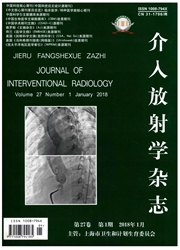

 中文摘要:
中文摘要:
目的研究流固耦合作用下颈动脉内一个心动周期典型时刻血流动力学分布,探索颈动脉粥样斑块形成与发展机制。方法采用计算流体力学方法对一个心动周期颈动脉内血流特性进行数值分析,根据血流动力学特征参数分析心动收缩期和心动舒张期对血流分布特性的影响。结果获得一个心动周期典型时刻颈动脉内血流特性分布情况。与心动舒张期相比,心动收缩期颈外动脉入口处分布较大面积血流停滞区,该区域内血流速度低,壁面压力低,壁面切应力低,管壁形变量和von Mises等效应力较大。结论流固耦合作用下颈动脉血流速度低引起血液回流,脂质、纤维等大分子易沉积:壁面压力低形成“负压”效应,正常血流发生改变,流动速度变慢,脑部供血不足;壁面切应力低使近壁面血流流态被破坏。血小板活性增强,内膜过度增生:管壁形变量和von Mises等效应力较大易引起应力集中,增大血管破裂风险。
 英文摘要:
英文摘要:
Objective To study the distribution of hemodynamics in carotid artery under the fluid- solid interaction at the typical point of time during a single cardiac cycle, and to explore the mechanism of the formation and development of carotid atherosclerofic plaque. Methods Numerical analysis the blood flow characteristics within a cardiac cycle in carotid artery was analyzed by using computational method of fluid dynamics. Based on the hemodynamic parameters, the influences of the cardiac systole and diastole on the blood flow distribution were analyzed. Results The distribution of blood flow in the carotid artery within a typical cardiac cycle was obtained. Compared with the findings in cardiac diastole, a larger area of blood stasis at the entrance of external carotid artery was observed. In this area, the flow velocity, the wall pressure and the wall shear stress were all lower, while the arterial wall deformation and yon Mises equivalent stress were larger. Conclusion Under fluid-solid interaction, the low blood flow in carotid artery causes blood reflux, resulting in the deposition of lipid, fiber and other large molecular materials. The low wall pressure produced "negative pressure" effect, thus the normal blood flow is changed, the flow velocity becomes slow, and the blood supply of the brain becomes insufficient. The low wall shear stress destroys the blood flow near the wall, causing the increase of platelet activity and intimal hyperplasia. The larger arterial wall deformation variable and yon Mises equivalent stress can cause stress concentration and increase vascular rupture risk.
 同期刊论文项目
同期刊论文项目
 同项目期刊论文
同项目期刊论文
 期刊信息
期刊信息
